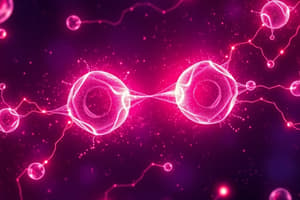Podcast
Questions and Answers
In water (H2O), each hydrogen atom has 2 valence electrons.
In water (H2O), each hydrogen atom has 2 valence electrons.
False (B)
Carbon dioxide (CO2) contains one double bond between the carbon and each oxygen atom.
Carbon dioxide (CO2) contains one double bond between the carbon and each oxygen atom.
False (B)
Oxygen has a total of 8 valence electrons when it forms bonds with carbon in carbon dioxide.
Oxygen has a total of 8 valence electrons when it forms bonds with carbon in carbon dioxide.
True (A)
Hydrogen atoms in water can share electrons to achieve full energy levels.
Hydrogen atoms in water can share electrons to achieve full energy levels.
Carbon has 6 valence electrons in carbon dioxide (CO2).
Carbon has 6 valence electrons in carbon dioxide (CO2).
Covalent bonding occurs when a metal atom shares electrons with another metal atom.
Covalent bonding occurs when a metal atom shares electrons with another metal atom.
In a covalent bond, both atoms involved can achieve a full orbital configuration.
In a covalent bond, both atoms involved can achieve a full orbital configuration.
Fluorine has six valence electrons and forms a single covalent bond by sharing one electron with another atom.
Fluorine has six valence electrons and forms a single covalent bond by sharing one electron with another atom.
A single covalent bond involves the sharing of four valence electrons.
A single covalent bond involves the sharing of four valence electrons.
Nonmetal elements can form covalent compounds.
Nonmetal elements can form covalent compounds.
In an ionic bond, specific atoms are joined like in covalent bonding.
In an ionic bond, specific atoms are joined like in covalent bonding.
Covalent bonds can only form between hydrogen and nonmetals.
Covalent bonds can only form between hydrogen and nonmetals.
Both atoms in a covalent bond ultimately obtain eight valence electrons.
Both atoms in a covalent bond ultimately obtain eight valence electrons.
Ionic bonds are formed when a nonmetal atom transfers electrons to a metal atom.
Ionic bonds are formed when a nonmetal atom transfers electrons to a metal atom.
Cations are formed when metal atoms gain electrons.
Cations are formed when metal atoms gain electrons.
Ionic compounds are characterized by a crystalline structure with a regular arrangement of ions.
Ionic compounds are characterized by a crystalline structure with a regular arrangement of ions.
When dissolved in water, ionic solids cannot conduct electricity.
When dissolved in water, ionic solids cannot conduct electricity.
Ionic solids are typically brittle due to the strong repulsion between like charges.
Ionic solids are typically brittle due to the strong repulsion between like charges.
A normal sodium atom becomes a sodium ion by gaining an electron.
A normal sodium atom becomes a sodium ion by gaining an electron.
When an atom gains one or more electrons, it becomes a positive anion.
When an atom gains one or more electrons, it becomes a positive anion.
The melting point of ionic compounds is typically low due to weak forces between ions.
The melting point of ionic compounds is typically low due to weak forces between ions.
Flashcards
Ionic Bonding
Ionic Bonding
Bonding between a metal and nonmetal where electrons are transferred.
Cation
Cation
Positively charged ion.
Anion
Anion
Negatively charged ion.
Ionic Compound
Ionic Compound
Signup and view all the flashcards
Electrostatic Force
Electrostatic Force
Signup and view all the flashcards
Crystalline Structure
Crystalline Structure
Signup and view all the flashcards
Melting Point (Ionic)
Melting Point (Ionic)
Signup and view all the flashcards
Electrical Conductivity (Ionic Solid)
Electrical Conductivity (Ionic Solid)
Signup and view all the flashcards
Electrical Conductivity (Ionic Liquid/Solution)
Electrical Conductivity (Ionic Liquid/Solution)
Signup and view all the flashcards
Covalent Bonding
Covalent Bonding
Signup and view all the flashcards
Covalent Bond
Covalent Bond
Signup and view all the flashcards
Single Covalent Bond
Single Covalent Bond
Signup and view all the flashcards
Double Covalent Bond
Double Covalent Bond
Signup and view all the flashcards
Triple Covalent Bond
Triple Covalent Bond
Signup and view all the flashcards
Molecule
Molecule
Signup and view all the flashcards
Brittle (Ionic)
Brittle (Ionic)
Signup and view all the flashcards
Study Notes
Ionic Bonding
- Ionic bonding occurs when a metal atom loses one or more electrons to a nonmetal atom.
- This results in both atoms having a full outer shell of eight valence electrons.
- The metal atom becomes a positively charged cation.
- The nonmetal atom becomes a negatively charged anion.
- The oppositely charged ions are attracted to each other, forming an ionic bond.
- Ionic compounds are held together by electrostatic forces.
- Examples of ionic bonds include sodium chloride (NaCl) and magnesium oxide (MgO).
Properties of Ionic Compounds
- Ionic compounds have a crystalline structure, with ions arranged in a regular repeating pattern.
- Ionic compounds are strong and rigid due to the strong electrostatic forces holding the ions together.
- They typically have high melting points.
- Ionic compounds are good conductors of electricity when dissolved in water or melted, because the ions are free to move.
- However, ionic compounds are poor conductors of electricity in their solid state, because the ions are fixed in a rigid structure.
- Ionic compounds are brittle, because the strong forces between the ions can be disrupted easily, leading to the crystal breaking apart.
Covalent Bonding
- Covalent bonding occurs when two nonmetal atoms share one or more pairs of electrons.
- This sharing of electrons allows both atoms to achieve a full outer shell of eight valence electrons.
- Covalent bonds form molecules, which are groups of two or more atoms held together by covalent bonds.
- Examples of covalent bonds include water (H2O) and carbon dioxide (CO2).
Types of Covalent Bonds
- Single Covalent Bond: Involves the sharing of one pair of electrons between two atoms. For example, the bond between the hydrogen atoms in a water molecule.
- Double Covalent Bond: Involves the sharing of two pairs of electrons between two atoms. For example, the bonds between the carbon and oxygen atoms in a carbon dioxide molecule.
- Triple Covalent Bond: Involves the sharing of three pairs of electrons between two atoms. An example of this is nitrogen gas, N2.
Studying That Suits You
Use AI to generate personalized quizzes and flashcards to suit your learning preferences.




